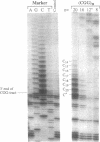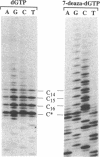Abstract
A large increase in the length of a CGG tandem array is associated with a number of triplet expansion diseases, including fragile X syndrome, the most common cause of heritable mental retardation in humans. Expansion results in the appearance of a fragile site on the X chromosome in the region of the CGG array. We show here that CGG repeats readily form a series of barriers to DNA synthesis in vitro. There barriers form only when the (CGG)n strand is used as the template, are K(+)-dependent, template concentration-independent, and involve hydrogen bonding between guanines. Chemical modification experiments suggest these blocks to DNA synthesis result from the formation of a series of intrastrand tetraplexes. A number of lines of evidence suggest that both triplet expansion and chromosome fragility are the result of replication defects. Our data are discussed in the light of such evidence.
Full text
PDF
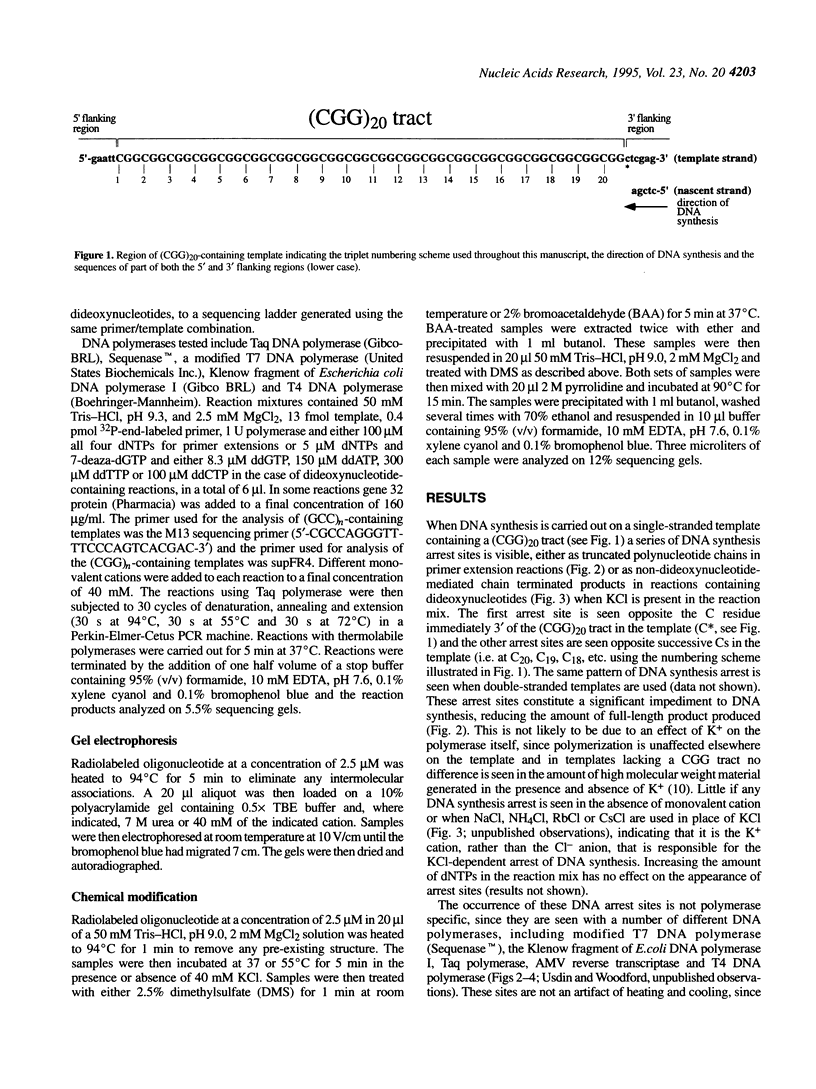
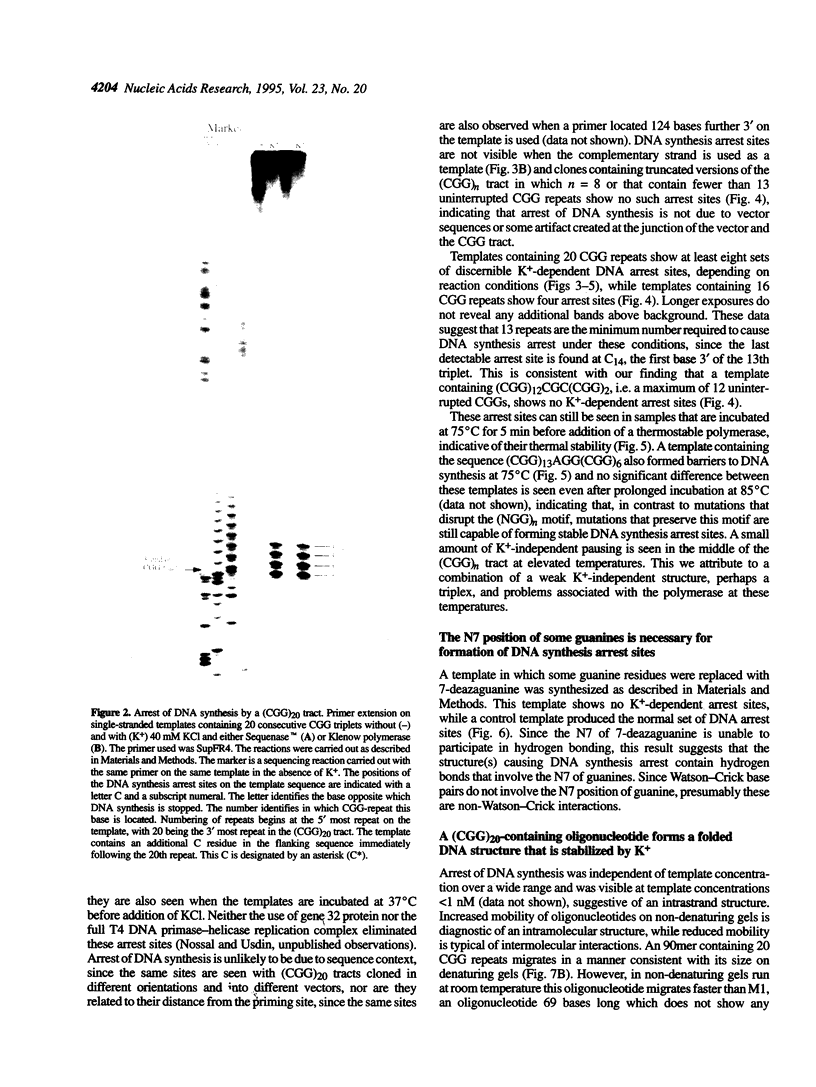
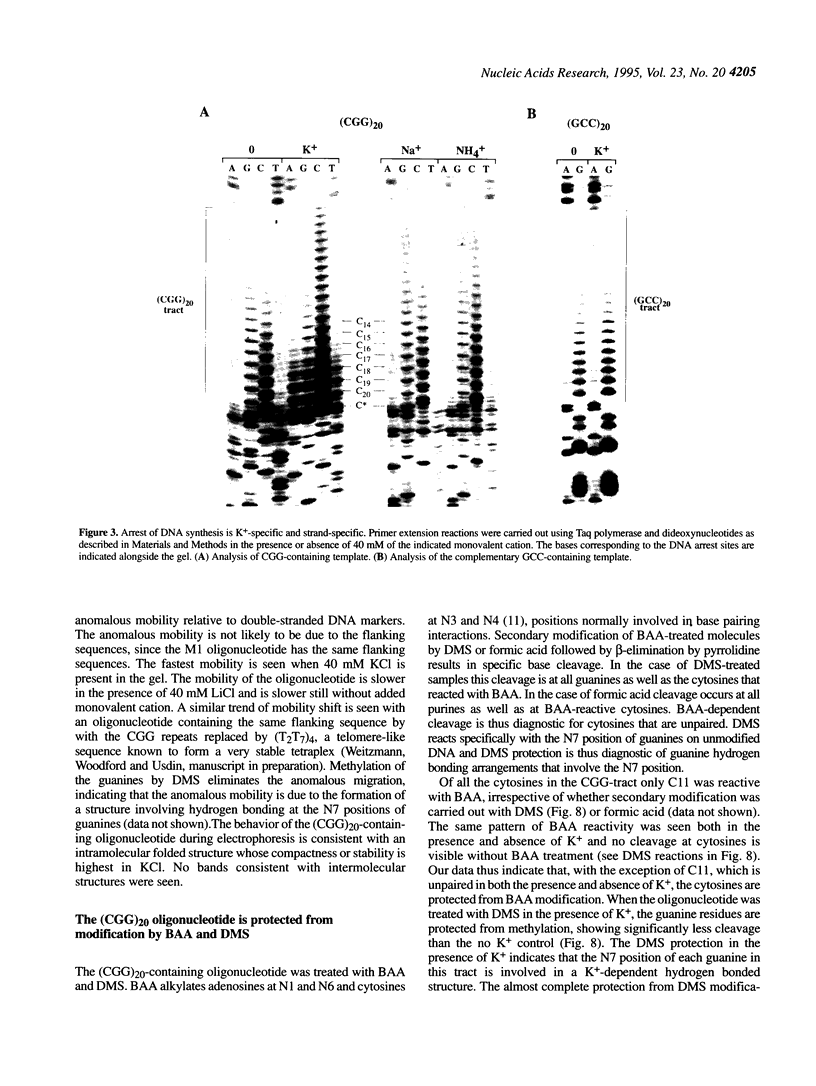

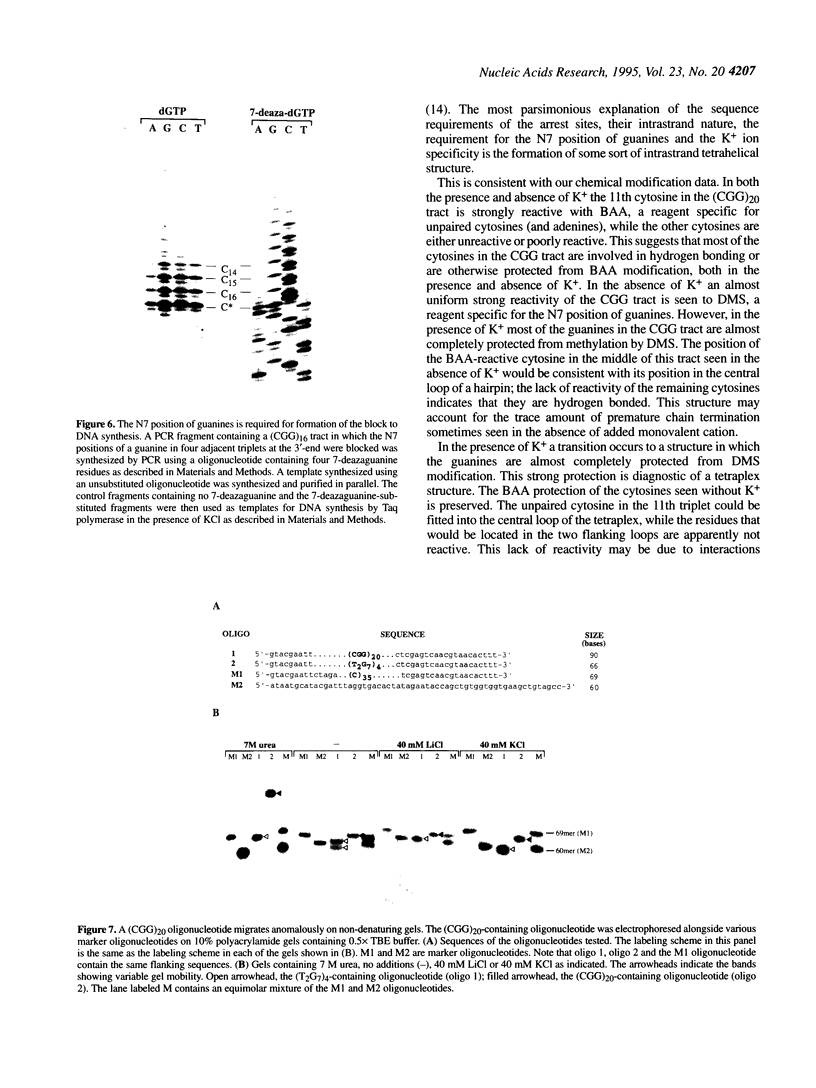


Images in this article
Selected References
These references are in PubMed. This may not be the complete list of references from this article.
- Aboul-ela F., Koh D., Tinoco I., Jr, Martin F. H. Base-base mismatches. Thermodynamics of double helix formation for dCA3XA3G + dCT3YT3G (X, Y = A,C,G,T). Nucleic Acids Res. 1985 Jul 11;13(13):4811–4824. doi: 10.1093/nar/13.13.4811. [DOI] [PMC free article] [PubMed] [Google Scholar]
- Baran N., Lapidot A., Manor H. Formation of DNA triplexes accounts for arrests of DNA synthesis at d(TC)n and d(GA)n tracts. Proc Natl Acad Sci U S A. 1991 Jan 15;88(2):507–511. doi: 10.1073/pnas.88.2.507. [DOI] [PMC free article] [PubMed] [Google Scholar]
- Fry M., Loeb L. A. The fragile X syndrome d(CGG)n nucleotide repeats form a stable tetrahelical structure. Proc Natl Acad Sci U S A. 1994 May 24;91(11):4950–4954. doi: 10.1073/pnas.91.11.4950. [DOI] [PMC free article] [PubMed] [Google Scholar]
- Fu Y. H., Kuhl D. P., Pizzuti A., Pieretti M., Sutcliffe J. S., Richards S., Verkerk A. J., Holden J. J., Fenwick R. G., Jr, Warren S. T. Variation of the CGG repeat at the fragile X site results in genetic instability: resolution of the Sherman paradox. Cell. 1991 Dec 20;67(6):1047–1058. doi: 10.1016/0092-8674(91)90283-5. [DOI] [PubMed] [Google Scholar]
- Glover T. W., Stein C. K. Chromosome breakage and recombination at fragile sites. Am J Hum Genet. 1988 Sep;43(3):265–273. [PMC free article] [PubMed] [Google Scholar]
- Hammond-Kosack M. C., Kilpatrick M. W., Docherty K. Analysis of DNA structure in the human insulin gene-linked polymorphic region in vivo. J Mol Endocrinol. 1992 Dec;9(3):221–225. doi: 10.1677/jme.0.0090221. [DOI] [PubMed] [Google Scholar]
- Hardin C. C., Corregan M., Brown B. A., 2nd, Frederick L. N. Cytosine-cytosine+ base pairing stabilizes DNA quadruplexes and cytosine methylation greatly enhances the effect. Biochemistry. 1993 Jun 8;32(22):5870–5880. doi: 10.1021/bi00073a021. [DOI] [PubMed] [Google Scholar]
- Hirst M. C., Barnicoat A., Flynn G., Wang Q., Daker M., Buckle V. J., Davies K. E., Bobrow M. The identification of a third fragile site, FRAXF, in Xq27--q28 distal to both FRAXA and FRAXE. Hum Mol Genet. 1993 Feb;2(2):197–200. doi: 10.1093/hmg/2.2.197. [DOI] [PubMed] [Google Scholar]
- Knight S. J., Voelckel M. A., Hirst M. C., Flannery A. V., Moncla A., Davies K. E. Triplet repeat expansion at the FRAXE locus and X-linked mild mental handicap. Am J Hum Genet. 1994 Jul;55(1):81–86. [PMC free article] [PubMed] [Google Scholar]
- Kohwi Y., Kohwi-Shigematsu T. Magnesium ion-dependent triple-helix structure formed by homopurine-homopyrimidine sequences in supercoiled plasmid DNA. Proc Natl Acad Sci U S A. 1988 Jun;85(11):3781–3785. doi: 10.1073/pnas.85.11.3781. [DOI] [PMC free article] [PubMed] [Google Scholar]
- Kremer E. J., Pritchard M., Lynch M., Yu S., Holman K., Baker E., Warren S. T., Schlessinger D., Sutherland G. R., Richards R. I. Mapping of DNA instability at the fragile X to a trinucleotide repeat sequence p(CCG)n. Science. 1991 Jun 21;252(5013):1711–1714. doi: 10.1126/science.1675488. [DOI] [PubMed] [Google Scholar]
- Kunkel T. A. DNA replication fidelity. J Biol Chem. 1992 Sep 15;267(26):18251–18254. [PubMed] [Google Scholar]
- Kunst C. B., Warren S. T. Cryptic and polar variation of the fragile X repeat could result in predisposing normal alleles. Cell. 1994 Jun 17;77(6):853–861. doi: 10.1016/0092-8674(94)90134-1. [DOI] [PubMed] [Google Scholar]
- Liu Z., Gilbert W. The yeast KEM1 gene encodes a nuclease specific for G4 tetraplex DNA: implication of in vivo functions for this novel DNA structure. Cell. 1994 Jul 1;77(7):1083–1092. doi: 10.1016/0092-8674(94)90447-2. [DOI] [PubMed] [Google Scholar]
- Macpherson J. N., Bullman H., Youings S. A., Jacobs P. A. Insert size and flanking haplotype in fragile X and normal populations: possible multiple origins for the fragile X mutation. Hum Mol Genet. 1994 Mar;3(3):399–405. doi: 10.1093/hmg/3.3.399. [DOI] [PubMed] [Google Scholar]
- McDermott A., Walters R., Howell R. T., Gardner A. Fragile X chromosome: clinical and cytogenetic studies on cases from seven families. J Med Genet. 1983 Jun;20(3):169–178. doi: 10.1136/jmg.20.3.169. [DOI] [PMC free article] [PubMed] [Google Scholar]
- Mixon J. C., Dev V. G. Fragile X expression is decreased by 5-azacytidine and S-adenosylhomocysteine. Am J Hum Genet. 1983 Nov;35(6):1270–1275. [PMC free article] [PubMed] [Google Scholar]
- Nancarrow J. K., Kremer E., Holman K., Eyre H., Doggett N. A., Le Paslier D., Callen D. F., Sutherland G. R., Richards R. I. Implications of FRA16A structure for the mechanism of chromosomal fragile site genesis. Science. 1994 Jun 24;264(5167):1938–1941. doi: 10.1126/science.8009225. [DOI] [PubMed] [Google Scholar]
- Nussbaum R. L., Airhart S. D., Ledbetter D. H. A rodent-human hybrid containing Xq24-qter translocated to a hamster chromosome expresses the Xq27 folate-sensitive fragile site. Am J Med Genet. 1986 Jan-Feb;23(1-2):457–466. doi: 10.1002/ajmg.1320230137. [DOI] [PubMed] [Google Scholar]
- Sen D., Gilbert W. A sodium-potassium switch in the formation of four-stranded G4-DNA. Nature. 1990 Mar 29;344(6265):410–414. doi: 10.1038/344410a0. [DOI] [PubMed] [Google Scholar]
- Sklenár V., Feigon J. Formation of a stable triplex from a single DNA strand. Nature. 1990 Jun 28;345(6278):836–838. doi: 10.1038/345836a0. [DOI] [PubMed] [Google Scholar]
- Snow K., Tester D. J., Kruckeberg K. E., Schaid D. J., Thibodeau S. N. Sequence analysis of the fragile X trinucleotide repeat: implications for the origin of the fragile X mutation. Hum Mol Genet. 1994 Sep;3(9):1543–1551. doi: 10.1093/hmg/3.9.1543. [DOI] [PubMed] [Google Scholar]
- Woodford K. J., Howell R. M., Usdin K. A novel K(+)-dependent DNA synthesis arrest site in a commonly occurring sequence motif in eukaryotes. J Biol Chem. 1994 Oct 28;269(43):27029–27035. [PubMed] [Google Scholar]






